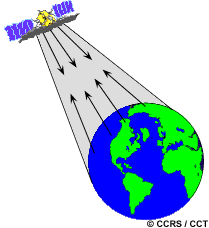
| Table of Contents |
1. Introduction |
|
2. Sensors 3. Microwaves 4. Image Analysis 5. Applications |
Fundamentals of Remote Sensing
1.6 Passive vs. Active Sensing
 So far, throughout this chapter, we have made various
references to the sun as a source of energy or radiation. The
sun provides a very convenient source of energy for remote
sensing. The sun's energy is either reflected, as it is for visible wavelengths, or absorbed and then re-emitted, as it is for
thermal infrared wavelengths. Remote sensing systems which
measure energy that is naturally available are called passive sensors. Passive sensors can only be used to detect energy when the naturally occurring energy is available. For all
reflected energy, this can only take place during the time when
the sun is illuminating the Earth. There is no reflected energy
available from the sun at night. Energy that is naturally emitted
(such as thermal infrared) can be detected day or night, as
long as the amount of energy is large enough to be recorded.
So far, throughout this chapter, we have made various
references to the sun as a source of energy or radiation. The
sun provides a very convenient source of energy for remote
sensing. The sun's energy is either reflected, as it is for visible wavelengths, or absorbed and then re-emitted, as it is for
thermal infrared wavelengths. Remote sensing systems which
measure energy that is naturally available are called passive sensors. Passive sensors can only be used to detect energy when the naturally occurring energy is available. For all
reflected energy, this can only take place during the time when
the sun is illuminating the Earth. There is no reflected energy
available from the sun at night. Energy that is naturally emitted
(such as thermal infrared) can be detected day or night, as
long as the amount of energy is large enough to be recorded.
 Active sensors, on the other hand, provide their own
energy source for illumination. The sensor emits radiation
which is directed toward the target to be investigated. The
radiation reflected from that target is detected and measured
by the sensor. Advantages for active sensors include the
ability to obtain measurements anytime, regardless of the time
of day or season. Active sensors can be used for examining
wavelengths that are not sufficiently provided by the sun, such
as microwaves, or to better control the way a target is
illuminated. However, active systems require the generation of
a fairly large amount of energy to adequately illuminate
targets. Some examples of active sensors are a laser
fluorosensor and a synthetic aperture radar (SAR).
Active sensors, on the other hand, provide their own
energy source for illumination. The sensor emits radiation
which is directed toward the target to be investigated. The
radiation reflected from that target is detected and measured
by the sensor. Advantages for active sensors include the
ability to obtain measurements anytime, regardless of the time
of day or season. Active sensors can be used for examining
wavelengths that are not sufficiently provided by the sun, such
as microwaves, or to better control the way a target is
illuminated. However, active systems require the generation of
a fairly large amount of energy to adequately illuminate
targets. Some examples of active sensors are a laser
fluorosensor and a synthetic aperture radar (SAR).
| Updated2002-08-21 | Important Notices |

